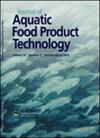Microbial Succession and Flavor Changes During Fermentation of Semi-Dried Sea Bass ( Lateolabrax maculatus )
IF 1.3
4区 农林科学
Q4 FOOD SCIENCE & TECHNOLOGY
引用次数: 0
Abstract
ABSTRACTThe Chinese traditional food, fermented semi-dried sea bass (FSSB), is famous for its unique flavor. The microbiota succession and flavor formation during fermentation remain unknown. This study utilized high-throughput sequencing to investigate the evolving microbiota and chemical determination to explore volatile compounds. The relevant abundance of microorganisms in the middle-fermented stage was significantly (p <.05) higher than that of the post-fermented stage. In addition, the main microbial phyla during fermentation were Firmicutes and Proteobacteria. In conclusion, this study contributes to understanding the changes in flavor substances during fermentation and the varying patterns of change among different floras.KEYWORDS: Fermented fishsea bassflavor compoundshigh-throughput sequencing Disclosure statementNo potential conflict of interest was reported by the author(s).Additional informationFundingThis work was supported by the Tianjin Agriculture and Rural Committee [Contract no.: 201801170]; Tianjin Municipal Science and Technology Bureau [Contract no.: 17ZXYENC00140].半干黑鲈发酵过程中微生物演替及风味变化
摘要发酵半干鲈鱼是中国传统食品,以其独特的风味而闻名。发酵过程中微生物群的继承和风味的形成尚不清楚。本研究利用高通量测序研究进化的微生物群和化学测定来探索挥发性化合物。发酵中期相关微生物丰度显著(p < 0.05)高于发酵后。发酵过程中主要的微生物门为厚壁菌门和变形菌门。综上所述,本研究有助于了解发酵过程中风味物质的变化以及不同菌群之间的变化规律。关键词:发酵鱼海鲈鱼风味化合物高通量测序披露声明作者未报告潜在利益冲突。本研究得到天津市农业和农村委员会的支持[合同编号:: 201801170);天津市科学技术局[合同编号:: 17 zxyenc00140]。
本文章由计算机程序翻译,如有差异,请以英文原文为准。
求助全文
约1分钟内获得全文
求助全文
来源期刊
CiteScore
3.50
自引率
6.20%
发文量
77
审稿时长
7 months
期刊介绍:
The Journal of Aquatic Food Product Technology publishes research papers, short communications, and review articles concerning the application of science and technology and biotechnology to all aspects of research, innovation, production, and distribution of food products originating from the marine and freshwater bodies of the world. The journal features articles on various aspects of basic and applied science in topics related to:
-harvesting and handling practices-
processing with traditional and new technologies-
refrigeration and freezing-
packaging and storage-
safety and traceability-
byproduct utilization-
consumer attitudes toward aquatic food.
The Journal also covers basic studies of aquatic products as related to food chemistry, microbiology, and engineering, such as all flora and fauna from aquatic environs, including seaweeds and underutilized species used directly for human consumption or alternative uses. Special features in the journal include guest editorials by specialists in their fields and book reviews covering a wide range of topics.

 求助内容:
求助内容: 应助结果提醒方式:
应助结果提醒方式:


